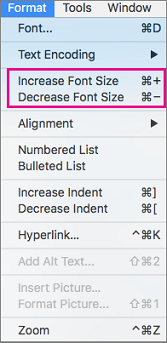
To change the font size for the column headings in your inbox, press C. Tip: To quickly go to your Inbox, press Ctrl+Shift+I. The Advanced View Settings: Compact dialog box opens. In Outlook, go to your Inbox, and press Alt+V, V. The layout of your inbox is called a view, and you can customize it-or even build new views-using the View tab in your Outlook. To accept the change and apply the new font size, press the Tab key until you hear "OK, button," and press Enter.Ĭhange the font size for your inbox items The Font dialog box closes and you return to the Signatures and Stationery dialog box. To change it, type the size you want to use, such as 16, and press Enter. To move the focus to the Size field, press Alt+S. The Font dialog box opens with the focus in the Font field. To change the default font size for composing and reading plain text messages, press N. To change the default font size for replies and forwards, press O. To change the default font size for new email messages that you compose, press F. To move to the option you want to change, select one of the following: You can change the default font size for new messages that you compose, and your replies and forwarded messages independently. When you change the default font size, the selected size is applied every time you use Outlook. The new size is applied.Ĭhange the default font size for email messages Type the new font size you want to use, and press Enter. You hear the currently selected font size. When composing an email message, select the text to be resized, or place the focus in the message body if there's no text yet. To close the Outlook Options window and return to the Outlook main view, press the Tab key until you hear "OK button," and press Enter. To accept the change and apply the new font, press the Tab key until you hear "OK, button," and press Enter. The screen reader announces the fonts as you move. To browse the font options, press the Down arrow key. To change the default font for composing and reading plain text messages, press N. To change the default font for replies and forwards, press O. To change the default font for all new email messages that you compose, press F. To move to the option you want to change, do one or more of the following: The Signatures and Stationery dialog box opens with the Personal Stationery tab selected. Press Alt+F to move the focus to the Stationery and Fonts button, and then press Enter. Press the Down arrow key until you hear: "Mail." In Outlook, press Alt+F, T to open the Outlook Options window.
/002_increase-font-size-while-reading-outlook-1173699-6339079c55e94f0e8a2bee3c6ce2d513.jpg)
You can change the default font for new messages that you compose, and your replies and forwarded messages independently. When you change the default font, the selected font is applied every time you use Outlook. The selected font is applied.Ĭhange the default font for email messages When on the font you want to use, press Enter. Press the Down arrow key to move through the font options. When composing an email message, select the piece of text you want to change, or place the focus in the message body if there's no text yet. To replace a piece of text, press Shift+arrow keys until you've selected the piece of text you want, and then type the new text. To select text, press Shift+arrow keys until you've selected the piece of text you want.

To navigate the message text, use the arrow keys. When the focus moves to the message body, you hear the message title, followed by "Message, editing." In JAWS, you hear: "Message, edit." If needed, press the Tab key repeatedly to go to the message body. Note: To learn more about composing an email in Outlook, refer to Create and send email.


 0 kommentar(er)
0 kommentar(er)
